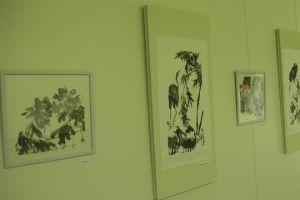Wang brings back eastern influences
September 24, 2011
The emphasis is on the briefness and firmness of strokes, with just the delicacy of the paper, precision is required. Too much ink and control will be lost. There is no erasing or going back.
With help from Sweet’s Sabbatical, a funding source for Washburn faculty to take time away from Kansas and study, Washburn professor Ye Wang studied in China for two months over the summer. During his sabbatical Wang worked on improving his ink painting techniques and studied under two master artists.
Su Maolong and Tang Yunming gave him many ideas for not only the painting aspect but teaching later in his lessons about the art of ink painting as well. Yunming specialized in mountain paintings while Maolong demonstrated calligraphy.
“I like landscapes, but I didn’t want to paint only landscapes or just figures,” said Wang.
Instead, Wang focused on flowers and birds for his series of ink paintings.
After his two month study Wang is closer to understanding the traditions of Chinese painters.
“In China, they believe in the Taoist philosophy,” said Wang. “They hide themselves in the mountains, away from reality. They believe this allows them to blend with nature.”
After the trip, Wang began to like ink painting more and more.
“It shows confidence in your drawing,” said Wang. “It doesn’t limit you by any rules from the realistic style. The opposite of accurate is fine, it allows a lot of flexibility and the focus is on inner expression.”
Figure drawing and painting are just two of the classes Wang teaches on campus. For painting classes, Wang demonstrates oil, watercolor, ink and other various techniques. His current exhibit was his first containing strictly ink paintings.
Wang’s previous exhibit “Reflection” on display was at Cottey College in Nevada, Mo. ended on Sept. 16. His “Reflection” collection was made up of just that, reflections.
Wang sets up a scene, has his subjects stand behind glass and he takes a photo. He then paints from the photo he takes. While he has a focus on each painting, he never knows what will be reflected in the glass. People walking by, cars, billboards, signs and whatever else comes in view that brief second are what will end up in the final painting.
“I’ve been working on these types of paintings for the last ten years or so, but I have an idea for what I’d like to do next,” said Wang.
Wang expressed his desire to go all the way back to the classics. Applying his same reflection technique, he wants to set up scenes from classical paintings. His emphasis is to reconstruct classical paintings and deconstruct them at the same time.
“This is what I’d like to do in the following years, maybe even another ten,” said Wang.
The Ink Painting Exhibition by Ye Wang is currently on display upstairs in the Art Building.



